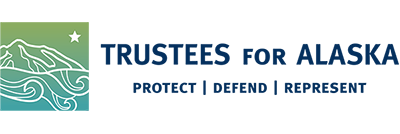
On beings and biomes—wetlands as the center of our everything
By Madison Grosvenor
In Crossing the Swamp, poet Mary Oliver immerses us in the thick, pulsing heart of the swamp. She calls it earthsoup, a word that conjures the richness and complexity of wetlands. To her, and to so many other beings, this place is the “center of everything.” A cosmos of life and decay, of constant transformation.
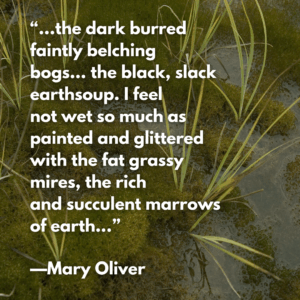
Excerpt from “Crossing the Swamp” by Mary Oliver. Photo by Steve Hillebrand.
Alaska’s wetlands are much the same: vast, diverse biomes that quietly sustain the balance of life.
Wetlands are areas of land where the soil is saturated with water, either permanently or seasonally. Stretching across millions of acres, from coastal marshes to interior peatlands, they are among the richest on Earth.
Oliver’s use of the term earthsoup is a visual feast. Mosaics of saturated soils, peat bogs, muskegs and minerally rich tundra swales mix with meltwater. Spongy mats of sphagnum moss and sedges quilt the landscape, floating atop permafrost and black muck soils that are fragrant with the scent of decay and new life. Black spruce trees rise out of the sodden ground, like charred matchsticks.
Beneath the seemingly inhospitable “muck” lies a dynamic world of microbial communities, on top, waterfowl nesting grounds, moose and bear habitat, and critical carbon storage. Like Oliver’s “succulent marrows of earth,” these wetlands feed entire food webs, and are central to the health of Alaska’s environment.
Across Alaska, there are many kinds of earthsoup. Each with its own unique chemistry, ecology, and role in the larger environmental system.
This earthsoup is a little salty!
With the longest coastline in the U.S., it’s no surprise that many of Alaska’s wetlands lie along its shores. Coastal wetlands, where freshwater meets saltwater, are nutrient-rich places teaming with diverse plant and animal life.

Salt marsh along the Tony Knowles coastal trail. Photo by Madison Grosvenor.
In Southcentral Alaska, one familiar type is the salt marsh—seen along the Tony Knowles Coastal Trail, the Seward Highway, the Homer Spit, and throughout Cook Inlet. These wetlands typically form at river mouths, behind barrier islands, spits, and tide flats where calm waters and sediment buildup create ideal conditions for salt-tolerant plants.
Grasses and sedges like hairgrass, Lyngbye’s sedge, salt grass, and alkali grass dominate the landscape, thriving in wet, salty soils. These species are specially adapted to frequent flooding and salt exposure, helping to stabilize sediment, filter water, and shelter wildlife.
Salt marshes act as natural nurseries for marine life, supporting young Pacific herring, Dungeness crab, and forage fish like stickleback. Rich in zooplankton such as copepods, they form a vital link in the coastal food web. These areas also serve as key stopover sites for geese, ducks, and shorebirds while predators like merlin hunt nearby.
Salt marshes help buffer storm surges, filter pollutants, and protect shorelines, making them essential to both wildlife and coastal communities.
Another critical coastal wetland type is the eelgrass bed, found in sheltered embayments like Izembek Lagoon in the Izembek National Wildlife Refuge, home to one of the world’s largest eelgrass meadows.
Rich in organic material, eelgrass beds support an abundant food web. Epiphytic algae, detritus, and associated micro-invertebrates form the base of this web, sustaining grazers like amphipods and isopods, which in turn feed fish, shorebirds, and marine mammals.
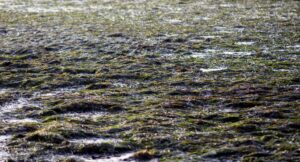
Eelgrass beds at low tide in Izembek National Wildlife Refuge. Photo by Rebecca Fabbri. USFWS.
Eelgrass also contributes significantly to nutrient cycling, stabilizing sediments, and enhancing water clarity by trapping particles and reducing coastal erosion. Additionally, eelgrass meadows sequester carbon in both their biomass and surrounding sediments, making them important natural carbon sinks in a changing climate. This helps mitigate climate change by reducing the amount of carbon dioxide in the atmosphere, thereby lessening the greenhouse effect and contributing to global climate regulation.
Tens of thousands of Pacific black brant rely on Izembek’s eelgrass each fall to build fat reserves before migrating to Mexico and California. These beds also support Alaska Native communities who depend on local wildlife like black brant and herring for food and cultural traditions.
This earthsoup is fresh!
Alaska has approximately 130 million acres of wetlands, which is about 63 percent of the nation’s wetland ecosystems. Among them, Alaska’s freshwater wetlands stretch across forests, tundra, and river valleys.
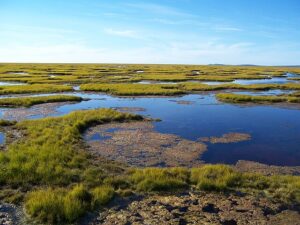
Sedge bogs of the Yukon Delta. Photo by Fred Broerman.
These wetlands naturally filter water, trap sediments and pollutants, and act like sponges by absorbing excess rain and snowmelt, reducing the risk of floods and stabilizing water supplies. This is especially important in Alaska’s rural and coastal areas, where communities rely on clean, steady sources of water and protection from extreme weather.
Most of Alaska’s freshwater wetlands fall under the palustrine system, an inland marsh, bog or swamp with intermittent sources of water, and including both peatlands and non-peatlands.
Peatlands are defined by thick layers of peat, a type of organic soil formed when dead plant material builds up faster than it decomposes. This slow decay happens in waterlogged, oxygen-poor soils, often found in low-lying or poorly drained areas.
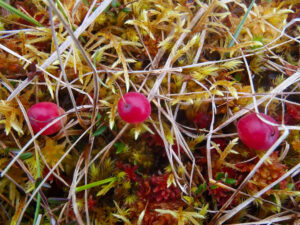
Cranberries ripen in the muskeg near Sitka, AK. Photo courtesy of the USDA.
Bogs and fens are the two main types of peatlands in Alaska. Bogs form in flat areas where rain and snow are the main water sources, and are home to sphagnum and feather mosses, and cranberries. Fens occur on gentle slopes with some groundwater flow and are dominated by brown mosses, grasses, and sedges. Fens support a greater diversity of plants and animals due to their higher nutrient content.
Alaska’s bogs and fens provide habitat for a variety of wildlife, including moose, beavers, nesting waterfowl, sandhill cranes, and insect-loving birds like yellow warblers and tree swallows. Many insects, including mosquitoes, dragonflies, and midges, rely on the standing water and rich plant life of bogs and fens for breeding and food.
Peatlands like bogs and fens store vast amounts of carbon and help to regulate climate, slowing the effects of global warming. However, in recent summers, a study has shown that peatlands in Alaska face growing threats from increasing wildfires driven by warmer, drier conditions and reduced soil moisture. A projected doubling of burned peatland area by the end of the 21st century, suggests that wildfires will progressively encroach further into organic-rich moist and wet peaty soils, amplifying soil carbon release across the entire state.
Black spruce–covered wetlands, known as muskeg, can be either bogs or fens depending on their water source. In interior Alaska, massive bog and fen systems stretch across 9 million acres of permafrost-rich lowlands, while in the mountainous southeast, fens are more common along slopes and valley floors. These forested wetlands, dominated by trees like spruce and alder, offer year-round shelter and food for species such as moose and songbirds.
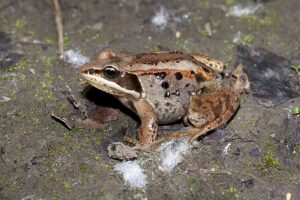
Wood frog emerges after a long winter. Photo by Kristof Zyskowski.
Freshwater marshlands, though less extensive than peatlands, are an important part of Alaska’s wetland landscape. These wetlands are characterized by open, shallow water areas dominated by grasses, reeds, sedges, and other herbaceous plants. Unlike peatlands, marshes typically have mineral-rich soils and more dynamic water levels, often influenced by seasonal flooding or river flow. They provide critical habitat for a wide variety of waterfowl, shorebirds, and fish, serving as breeding, nesting, and feeding grounds.
In addition, freshwater marshes support diverse populations of amphibians, insects, and mammals. The wood frog—the only amphibian in Alaska—is a common marshland inhabitant, capable of surviving the Arctic winter by freezing solid. They do this by producing large amounts of glucose that prevents ice from forming within their cells, allowing them to revive when the marsh thaws out come spring.

Riparian zone in the Yukon Delta National Wildlife Refuge. Photo by Fred Broerman.
While freshwater marshes support a wide range of aquatic and terrestrial wildlife within standing water environments, riparian zones extend this ecological diversity along the flowing edges of rivers and streams, where land and water continuously interact.
Riparian zones are those lush areas along streams or riverbanks. Healthy riparian zones serve as a sort of connective bridge between aquatic and upland areas. These wetland zones are vital corridors for salmon migration and help stabilize riverbanks, reducing erosion.

Juvenile salmon rest within the riparian zone of the Kenai River. Photo by Katina Mueller.
Riparian zones provide essential habitat features tailored to the needs of different fish species throughout their life cycles. For salmonids, riparian vegetation offers food, shade, and shelter that aid in camouflage and survival.
Other fish like rainbow trout, arctic grayling, and dolly varden, are resident species in the riparian zone, remaining in freshwater year-round. These resident fish use vegetated areas in the riparian zone for their ability to help regulate water temperature, slow nearshore stream velocities, and create resting spots for juvenile fish.
Together, Alaska’s diverse freshwater wetlands play a vital role in supporting ecosystems and communities. As we move northward, these functions become even more critical in the unique and fragile tundra wetlands.
This earthsoup is ice cold!
Tundra wetlands dominate the northern and western reaches of Alaska, where flat terrain, slow drainage, and permafrost define the landscape.

Wetlands on the Arctic coastal plain. Photo by Lisa Hupp, USFWS
In these regions, continuous permafrost lies beneath the tundra, keeping the ground frozen year-round except beneath large lakes and rivers that don’t freeze completely solid.
Above this icy foundation is the active layer, a surface layer of soil that thaws each summer and refreezes in winter. When the active layer melts, water from snowmelt and rainfall saturates the soil, unable to drain through the permafrost below. This creates the waterlogged conditions that give rise to the tundra’s extensive wetlands.
These wetlands form patchworks of lakes, ponds, bogs, marshes, and riparian zones, creating a mosaic of habitats across Alaska’s tundra. The treeless landscape is dominated by low-growing vegetation—mosses, lichens, dwarf birch, and willow shrubs. In late summer and early fall, berry-producing plants like lingonberries, cloudberries, and bearberries add to the seasonal abundance.
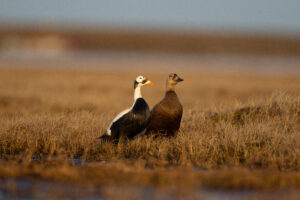
A pair of spectacled eiders rests at the edge of a tundra pond within the Arctic Refuge. Peter Pearsall.
Despite the short growing season, tundra wetlands become highly productive during the summer months, supporting an explosion of life: millions of migratory birds return to breed, drawn by the plentiful food and nesting grounds; fish and invertebrates thrive in flooded lowlands; and massive caribou herds migrate across the plains, grazing on early-sprouting sedges essential for post-calving recovery.
One of the most ecologically rich examples of this system lies on the Arctic Coastal Plain and the Arctic National Wildlife Refuge. Tucked between the icy Beaufort Sea and the rugged foothills of the Brooks Range, this 1.56-million-acre region stretches eastward to the Yukon border. It harbors one of the largest and most intact wetland complexes in North America. The poorly drained, treeless plain gradually rises from sea level to the glaciated mountains, with extensive permafrost acting as a barrier that traps moisture. This creates a spongy, saturated landscape dense with shallow thaw lakes, ponds, and marshes.
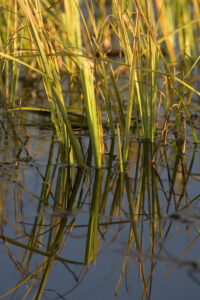
Close up of permafrost pond in the Arctic National Wildlife Refuge. Photo by Steve Hillebrand.
The Arctic Coastal Plain is especially notable for its extremely high density of wetlands.
Near the Beaufort Sea coast, shallow thaw-lake wetlands are particularly abundant, serving as critical habitat for breeding waterfowl, like snow geese and pacific loons.
Each spring, melting snow flows across still-frozen ground, filling thawed basins, braided streams, and river channels. Repeated cycles of freezing and thawing will gradually enlarge these basins, and dynamic processes like shoreline breaching and drainage shape and mold the evolving wetland patterns.
In this Arctic landscape, where ice and water define both the terrain and the ecology, these tundra wetlands serve as a critical hub of biodiversity.
“Wet thick cosmos, the center of everything…”
What we are doing to wetlands
The largest tract of public land in the United States is a wild expanse of tundra and wetlands stretching across nearly 23 million acres of the western Arctic in northern Alaska. This region is the National Petroleum Reserve–Alaska. Between Point Barrow and Prudhoe Bay, up to 86 percent of the landscape in some areas is covered by water.
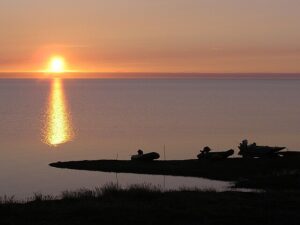
Researchers’ boats beached on the shore of Teshekpuk Lake, National Petroleum Reserve. Photo by Tim Craig.
Teshekpuk Lake lies in the northeastern corner of the reserve. In the Iñupiaq language, “Teshekpuk” translates to “great enclosed water” or “big coastal lake.”
The lake is surrounded by a network of ponds and smaller lakes, forming the larger Teshekpuk Lake wetlands complex. Here, high densities of shorebirds and waterfowl flock to this area every summer for its prime nesting habitat.
Arctic wetlands, along with the surrounding permafrost-rich tundra, store vast amounts of carbon that have been locked in frozen soil for thousands of years. This carbon reservoir acts as a natural climate regulator, keeping greenhouse gases out of the atmosphere. As the Arctic warms at nearly three times the global average, this frozen ground becomes increasingly vulnerable, threatening to release enormous quantities of carbon dioxide and methane into the atmosphere.

Coastal erosion in the Teshekpuk Lake Special Area of the National Petroleum Reserve. Photo by Brandt Meixell, USGS
Destructive extraction and industrial expansion in the Arctic, such as road building, oil drilling, and other invasive operations, pose a grave threat to the region’s sensitive wetlands. These wetland areas, vital for storing vast amounts of carbon, are especially vulnerable to disturbance. Extraction industries can accelerate permafrost thaw and coastal erosion within these ecosystems, tearing apart landscapes that have remained undisturbed for thousands of years and unlocking climate-warming carbon that had been safely sealed in frozen soils.
As these activities continue, they not only release trapped emissions but also drive further carbon pollution through their industrial processes.
In the Teshekpuk Lake wetlands, climate effects are already taking place. Melting sea ice near the lake and wetlands is accelerating coastal erosion, in some places pushing the sea inland by up to half a mile and salting freshwater lakes and ponds. This threatens vital habitat for migratory birds, caribou, and other wildlife. As the Arctic continues to warm, key nesting and insect-relief zones north of the lake face permanent loss.

Methane bubbles from melting permafrost rise to the surface of a tundra pond. Photo by Lisa Hupp.
When Arctic wetlands are disrupted, the consequences ripple far beyond the immediate area. The release of stored carbon and methane intensifies the warming of the planet, while the destruction of wetland ecosystems undermines their ability to function as carbon sinks in the future.
These changes feed into a dangerous climate feedback loop. Warming leads to more emissions, and more emissions lead to more warming.
What wetlands do for you
In Mary Oliver’s poem, we are immersed in the primordial nature and richness of the wetlands. A world that is both difficult to traverse and yet profoundly life-giving.
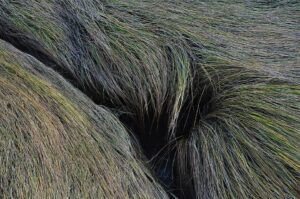
Grasses and sedges line the Anchorage Coastal Wildlife Refuge wetlands. Photo by Paxson Woelber.
She describes these “wet thick cosmos” not as an afterthought of nature, but as “the center of everything.” Here, Oliver reveals a deep truth: wetlands are foundational, not peripheral, to life on Earth.
Just as Oliver describes herself as ‘a poor dry stick given one more chance’ and finds renewal in the swamp’s embrace, so too do we—often unknowingly—draw life from these bogs, marshes, and fens.
They nourish our planet in quiet, powerful ways. They filter our water, buffer our coastlines, feed our food webs, and hold carbon deep in their soils. These systems support wildlife and sustain communities. They are the lungs and kidneys of our landscapes, and in places like Alaska, they form the very ground beneath our feet.
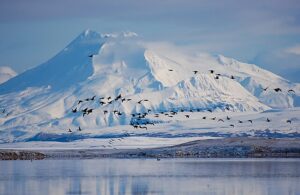
Silhouettes of black brant flying across the sky in front of a snowy mountain and wetlands. Credit: Kristine Sowl/USFWS
Alaska’s wetlands are vast, varied, and irreplaceable. From the salty beds of eelgrass that anchor migrating birds and stabilize shorelines, to the carbon-rich peatlands that slow the pace of global warming, to the frozen tundra marshes that burst with migratory life in summer, each wetland type plays a role in maintaining the planet’s balance.
To speak of wetlands is to speak of climate, culture, food, and our future. They are living systems with which we are entangled. They protect our homes from floods, keep our fisheries healthy, and offer refuge to wildlife and people alike. They are places of sustenance and sanctuary, traditions, and transformation.
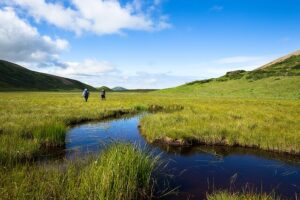
Two people hike with packs in a green landscape where a stream and wetland area wind through a valley. Credit: Lisa Hupp/USFWS.
In a rapidly changing world, wetlands offer a rare and vital form of continuity. They hold ancient carbon, ancestral memory, and enduring life. They are, as Oliver writes, “the center of everything.”
And they are asking something of us now… to see them not as background, but as essential.
To protect them not just for what they do for us, but because we, too, are part of this earthsoup.
This is the ninth in our “Beings and biomes” series. You can find previous articles below:
- On beings and biomes–the wolverine
- On beings and biomes—the boreal forest
- On beings and biomes—keystone and indicator species
- On beings and biomes—a year in the tundra
- On beings and biomes—an intertidal abundance
- On beings and biomes—beluga whales
- On beings and biomes—caribou and their migrations
- On beings and biomes—the perpetual homecoming of migratory birds


